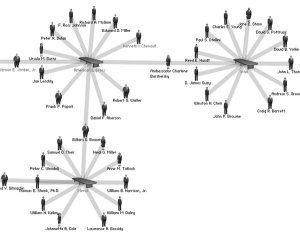Mapping politics through art. Is it effective?
When the french philosopher Alain Badiou presented his essay “Fifteen Thesis on Contemporary Art” published in 2004, he took an artwork by Mark Lombardi, as an illustration of his talk. This artwork was a map. It was more exactly a pencil diagram, entitled as “George W. Bush, Harken Energy and Jackson Stephens, ca 1979-90”, which shows all the social and power connections of James Bath, a former CIA spook and business broker, front man for Saudi money who connected the Bush Family and Bin Laden Family in shady deals in Texas and around the world.
Badiou described it as a “galaxy of corruption”. He said that Lombardi map (1999),- that is only one of his many diagrams related to corruption and political scandals- was a good example of what contemporary art should be today. To Badiou, this means that contemporary art is not about formalism and Romanticism. It is the field where creating a new possibility of knowledge should happen. And for create a new possibility, an artwork should have three main determinations:
a) A demonstration; a logical equation and coherence, consistence or any kind of eternity, because artistic creation is not only a question of pure communication or circulation. It is a question of something odd and is not in the constant modification of forms. “Something which resists and resistance is a question of art also today. Something which resists is something with some stability, solid”.
b) A Surprise, understood as the ability of art to present something before the facts, before the evidence. A kind of rupture, a new beginning. Lombardi explained the facts of the connections between Bin Laden and Bush family before September eleventh facts. Badiou described it (Lombardi diagram) as an artistic prophecy.
c) An aesthetic characteristic; calm, elevated. The shape is not purely conceptual, political or ideological. This new vision of the world, our world has its proper shape.
This is the Lombardi’s artwork:

In the last few years, many artists have been working on mapping politics, making things public through the maps. Maps have become an exercise of Situationist detournement theory, used for re-appropriating the tools of power. But in many cases, these maps are just immense representations of data and connections that are not effective as a tactical “artifact” and even are not artworks. There are two good examples of these kind of works to explain what Teodor Mitew have called “maps as unveiling”.
* Bureu d’Etudes “The World Government”


Both projects create “statics” maps full of interesting information of which the power connections are but not how these power connections work. First picture show the real connections but they missed the details of their movements, their paths when they are on translation. How it will be possible to mapping politics in a more accurate way, trying to get a more significant information?.
At the same time, Badiou argues that contemporary art should not look for totalitarian representations of the world. Art should be against the dream of totalization; “The dream of a complete multimedia was idea of Richard Wagner before, is not new, and this representation of totalities is something related to the dream of globalization”.
In my opinion, these projects could be part of a global representation of the world, something that actually is good for maintain the powerful structure of the Imperialism and Capitalism. Even if it is an interesting option to make things public, it is necessary to look into other data visualization methods too.
The increased importance of cartography and using maps for new media artists as a result of working with huge volume of data has to be researched. This post is the result of my first “analogic maps” approach to the subject. I will continue the research for new media theories research paper.